Nokia Lumia 930 Review
by Brett Howse on September 8, 2014 3:00 PM EST- Posted in
- Smartphones
- Microsoft
- Nokia
- Mobile
- windows phone
- Lumia
CPU Performance
The Lumia 930 is the second device from Nokia to utilize the Snapdragon 800 platform, with the Lumia 1520 6” Phablet also sporting the same SoC. In this particular case, it is the MSM8974VV variant which contains four Krait 400 cores at up to 2.2 GHz, along with as Adreno 330 GPU. The 930 also has 2 GB of LPDDR3 memory. This combination really kick-starts Windows Phone, which prior to the 1520 had been utilizing dual-core Krait 200 on the upper end models. The implications are dramatic, with the Lumia 930 providing a huge real-world increase in speed. Anyone who believes Windows Phone somehow does not need a faster SoC is kidding themselves, as this device has proven to me. App loading times are much quicker, and app rehydration, which is a huge issue on older devices, is so much quicker that it is almost instant. Skype is well known to all Windows Phone users for having sometimes ridiculous rehydration times, but the Snapdragon 800 almost completely overcomes this handicap.
We can use several benchmarking tools in order to quantify this difference in performance. We will start with some web based javascript tests, and then move on to some native benchmarking tools.
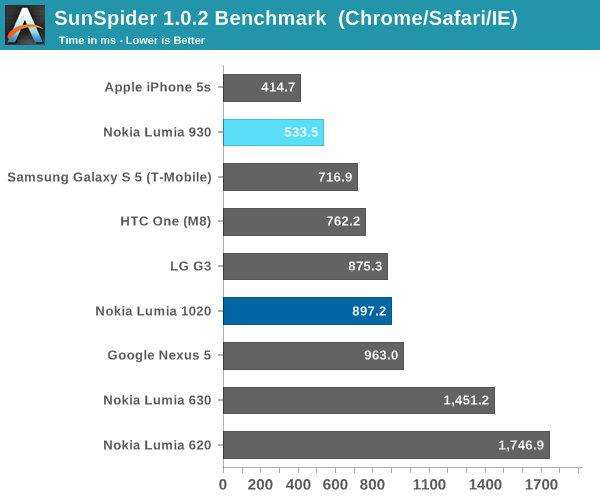
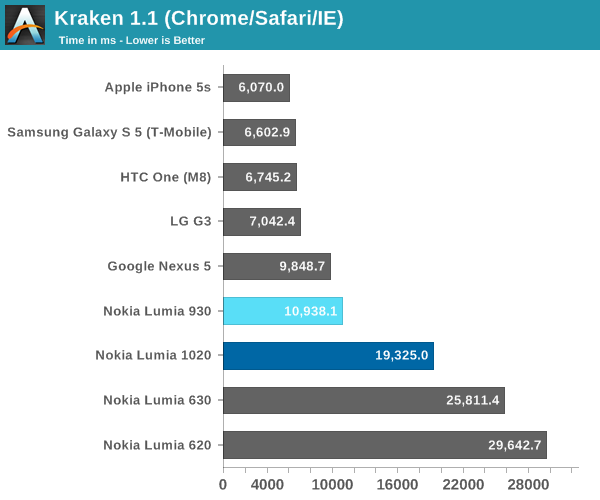
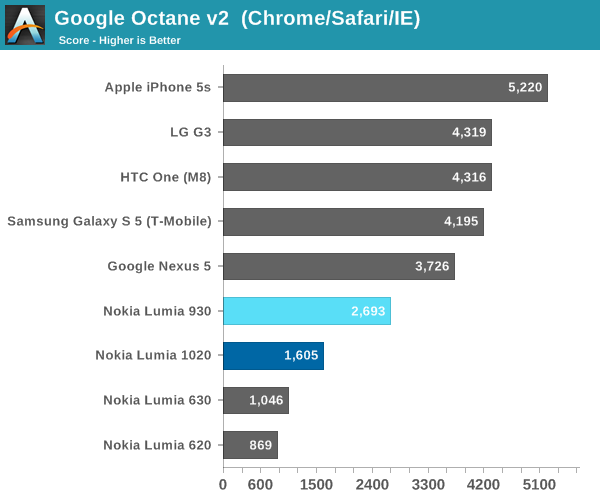
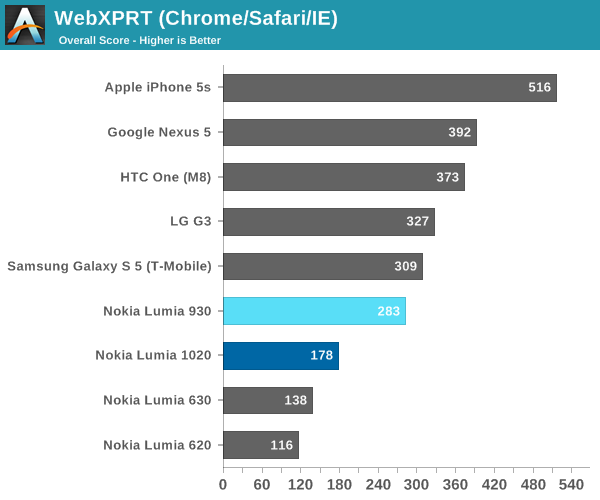
Sunspider has the Lumia 930 besting all but the iPhone 5s. Historically Internet Explorer has always done well at Sunspider though, and version 11 continues that trend. Unfortunately this benchmark has been optimized for by all companies. Moving up to more complex Javascript, we can see the difference with IE 11 compared to other browsers. The 930 falls behind the Google Nexus 5 which shares the same SoC, and it is well behind the Snapdragon 801 equipped phones. However the 930 scores almost half of the 1020 which is a great generational leap. A similar situation occurs on Google Octane, with the 930 behind the Nexus 5, but well ahead of last year’s Lumia devices. WebXPRT scores show the same trend. The Snapdragon 800 transforms Windows Phone into a contender. Javascript performance of IE 11 still is not as good as Chrome or Safari, but it is at least getting close with the latest version of the browser.
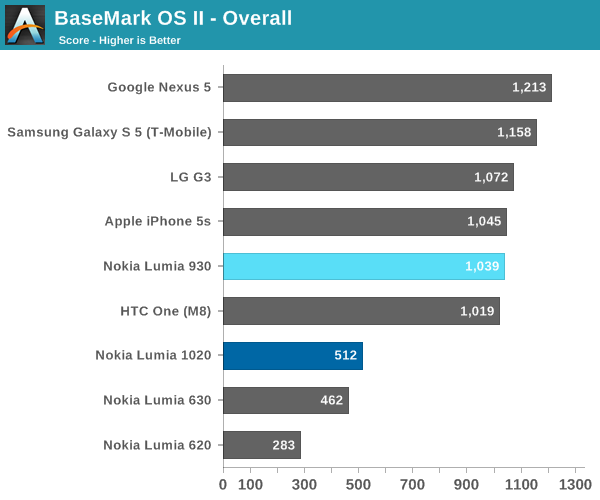
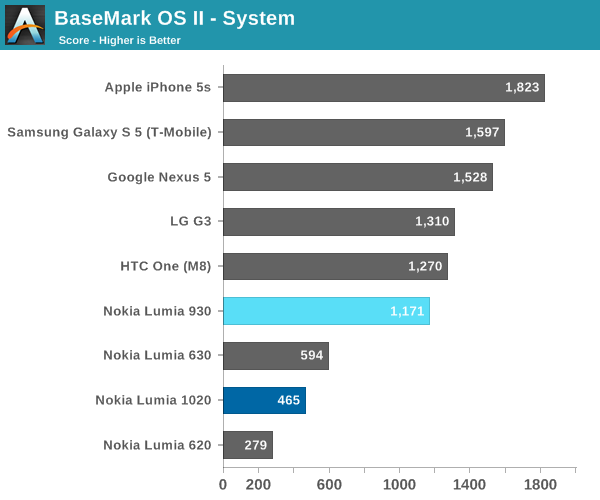
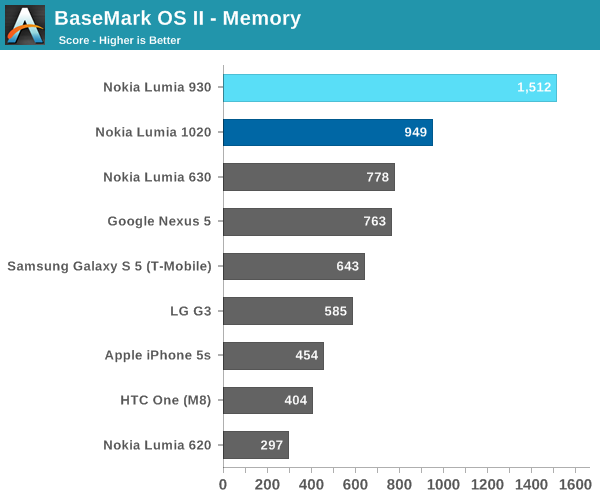
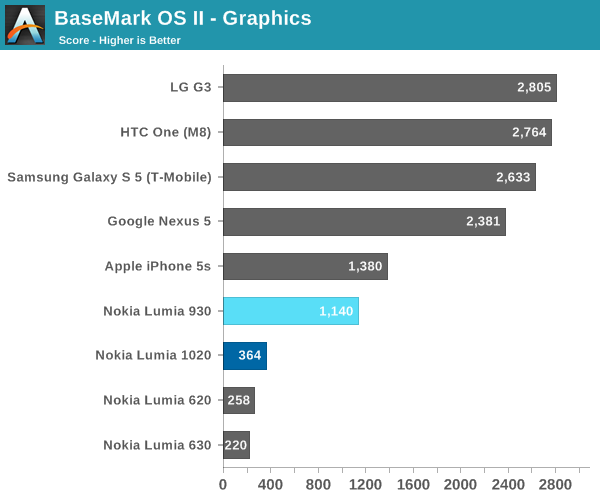
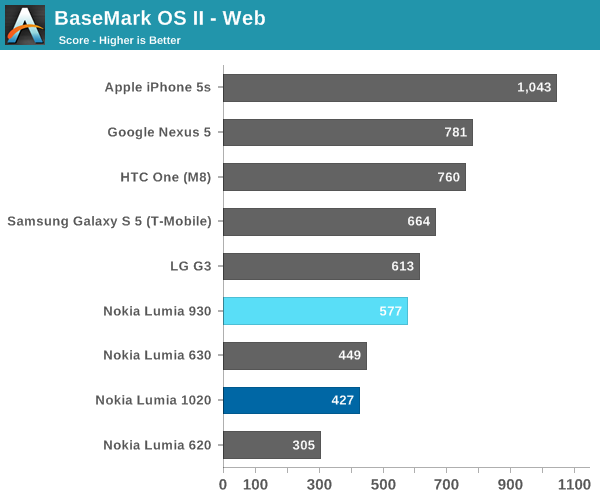
BaseMark runs as a native application, and therefore is not handicapped by the Javascript engine of the browser. Here the 930 performs well, with a score right around the same score as the iPhone 5s. Performance compared to the dual-core Krait 200 of the Lumia 1020 is once again pretty much doubled. Looking at the rest of the BaseMark scores, it becomes very clear how much of an improvement the 930 is over previous Windows Phones with MSM8960.
Graphics Performance
For GPU comparisons, we would normally turn to RightWare’s Basemark X 1.1, however a bug in the current version prevents it from running on the Lumia 1520 and Lumia 930. I have contacted them, and they have promised to look into it. If a patch is released, I will re-run the tests and update Bench. We do have access to GFXBench though, so let us see how the 930 performs.


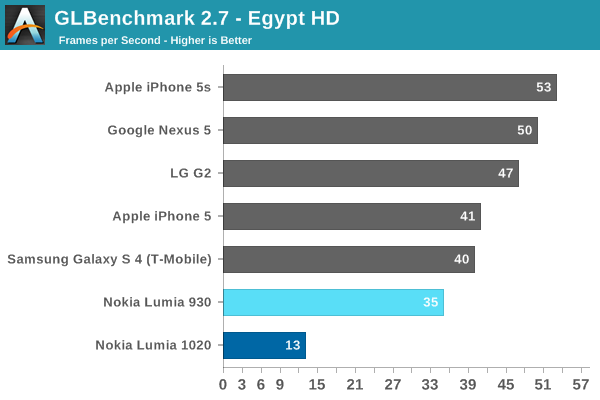
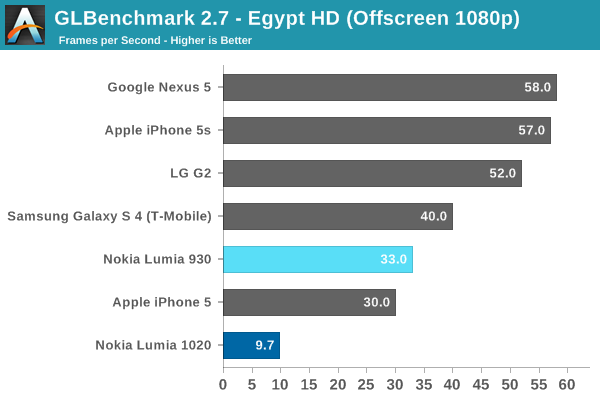
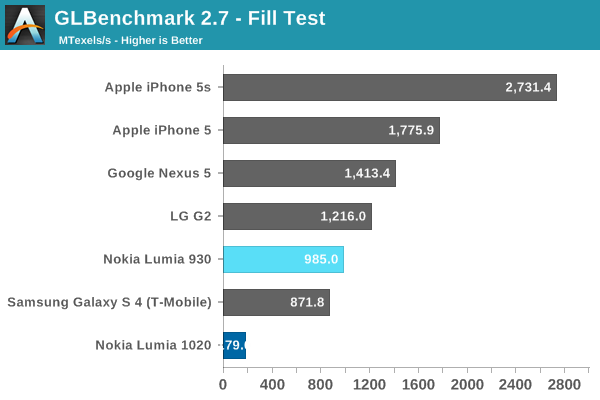
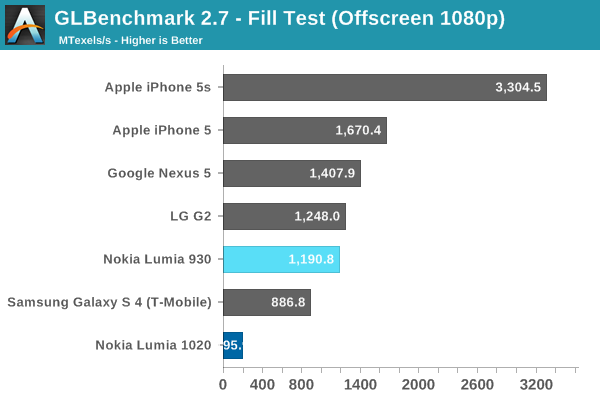


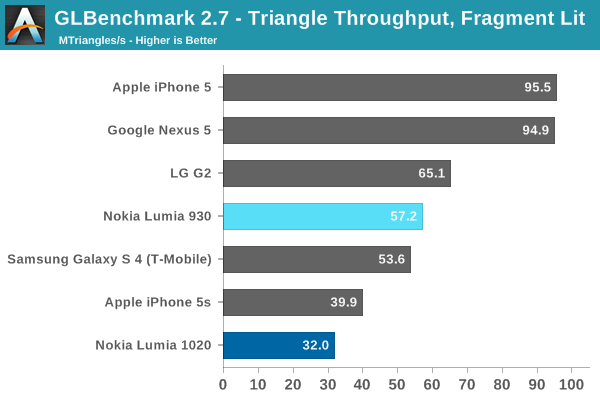
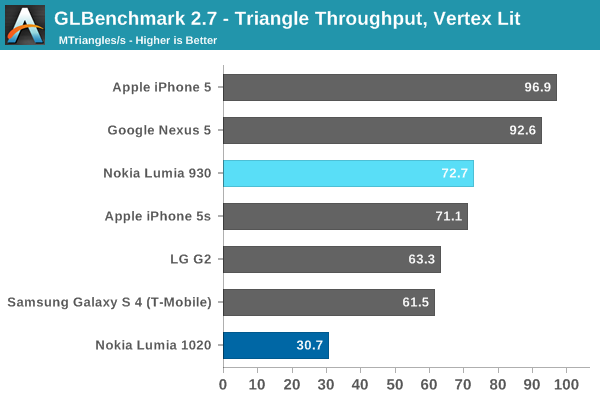

Version 2.7 of the benchmark is the current one for Windows Phone, with 3.0 listed as coming soon, however we can still get a glimpse at the huge performance leap from the last generation. While still not as quick through the benchmarks as Android and iOS, it is at least in the same room as them now.
Storage
Windows Phone does not support our storage benchmarking apps, and current ones in the store are either wildly inaccurate, or just provide abstract results. For this reason, we are going to create our own, but it is not ready yet. NAND performance was not tested on this device.
Performance Summary
One thing that Anand has harped on with regards to Windows Phone is that it is often on a much older SoC than competitive Android phones. This delta in performance is difficult to turn a blind eye to, even for supporters of the platform. With the 930 and Icon counterpart, Nokia has launched a phone which was on the most current SoC at the time of launch in February, which is a big step forward for Windows Phone performance. With the recent release of the HTC One (M8) for Windows, the platform now has the same SoC as most other flagship Android devices. That is a much bigger deal than many realize. The performance of Windows Phone has always been good on low end hardware, at least as far as the actual OS and animations, but in-app performance could suffer. The Lumia 930 is a breath of fresh air to Windows Phone and this one change alone is quite startling when compared to older devices.










115 Comments
View All Comments
Reflex - Monday, September 8, 2014 - link
I am honestly not certain why they are getting these results. I use my Icon all day every day and it has the longest battery life I've had on any phone since I had a flip phone. Better than my previous HTC 8X, better than the HTC Trophy before that. I get at least a solid day out of it, and I've gone two days before while out of town (although I was much more careful in my usage).I think there is something wrong for this test to be getting the results they are, whether with their hardware or with the test itself.
AlexOwliver - Monday, September 8, 2014 - link
Made an account just to comment on this review - I'm really happy that you guys are reviewing more WP handsets, even with the frustrating hardware stumbles that seem to accompany each generation.While the base WP isn't skinned by manufacturers, the Nokia firmware and software tweaks - glance, double tap to wake, sunlight readability, etc - are awesome and have been, up until the M8/Moto X, have been unique to WP.
The 801 is an up-binned 800. The 805 is an up-binned 801 with a (significantly) better GPU and Qualcomm themselves has said that clients are expected to pick one or the other rather than use both as an upgrade path. This doesn't excuse the 930 shipping with an 800, but it's a bit of an overstatement to say it's shipping 2 or 3 generations of chip behind.
What I would have liked to see was the 930 come in at a Nexus price. Position it like the Moto X (features, not specs) and introduce more people to the platform. Unfortunately, they pulled a typical Nokia, used cheaper components, focused on features, and then charged a premium price. Hopefully a US-centric version of the 830 will come out with an 800 at around $350. That would be a phone worth reviewing.
tuxRoller - Monday, September 8, 2014 - link
The 805 also has vastly more bandwidth.tuxRoller - Monday, September 8, 2014 - link
What's going on with the web battery life? The N5 has the same size screen and a smaller battery but far better battery life. Also, when did you start including basemark battery tests (I don't recall seeing that test on other reviews)? What do they measure, exactly? The basemark site isn't very forthcoming.Slightly surprised about winos generally poor performance compared to like silicon on Android. I thought it was supposed to be a more efficient platform?
Ryan Smith - Monday, September 8, 2014 - link
"Also, when did you start including basemark battery tests"We've had the data for some time now.
http://www.anandtech.com/bench/PhoneTablet14/992
tuxRoller - Tuesday, September 9, 2014 - link
Thanks! I hadn't seen that part of the site before.Brett Howse - Monday, September 8, 2014 - link
I contacted the authors of Basemark just the other day to get a better feel for how their score is calculated, but have not heard back yet.As far as the web battery life, the AMOLED panel in the Lumia 930 appears to be the same generation as the Galaxy S4, which also had terrible battery life http://www.anandtech.com/show/6914/samsung-galaxy-...
The Galaxy S4 has a slightly larger battery, and gets slightly longer battery life. Without pulling the phone apart, that is the best conclusion I can make based on my time with the device. Battery life on dark scenes is much better than our worst case scenario with the web test of white web pages.
tuxRoller - Tuesday, September 9, 2014 - link
Thanks for the comments.Might I suggest a more transparent (is, open source) test platform? They exist, even for mobile, and you can see exactly what they do.
For instance, linaro has released the benchmarks they use for internal testing of commits.
randomshinichi - Monday, September 8, 2014 - link
How did you measure the shot latency with such precision? In my experience, the iPhone 5S has the best shot latency, even more than the HTC One M8.notposting - Monday, September 8, 2014 - link
I set a Favorite in IE labeled "-jump to top", the target is: javascript:scroll(0,0) -- it works great.Also I get the same mobile NY Times site in IE10 on WP8...I believe a better example is supposed to be Twitter.